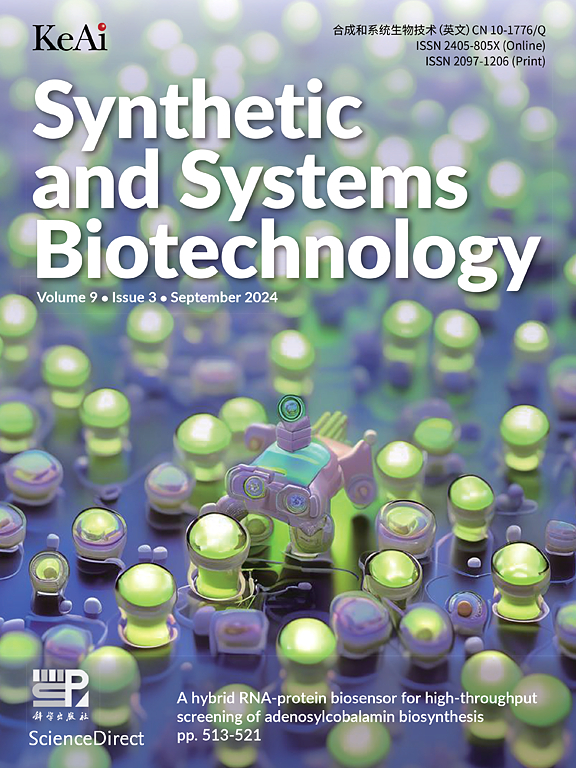crispr介导的多基因下调将代谢通量重定向到棘糖多孢子虫的生物合成
IF 4.4
2区 生物学
Q1 BIOTECHNOLOGY & APPLIED MICROBIOLOGY
引用次数: 0
摘要
微生物常被比作复杂的生产车间。在棘糖多孢子虫(Saccharopolyspora spinosa)中,棘糖苷的生物合成是其复杂车间中的一条生产线。优化整个生产环境,减少不必要的代谢流量是提高糖产量的关键。丙酮酸是生物合成棘糖的重要前体。先前的研究表明,pyc基因在糖异生途径中高度表达,导致丙酮酸分流。通过下调pyc,我们提高了spinosad产量,尽管改善程度低于预期。我们推测,pyc敲低后积累的大部分丙酮酸进入了一些与spinosad无关的合成途径。通过代谢途径和qRT-PCR分析,我们发现在pyc敲低菌株中,gltA1和atoB3在丙酮酸代谢分支(包括TCA循环和乙基丙二酰辅酶a途径)中的表达水平显著升高。这三个基因的联合敲除优化了spinosad生产线,使其产量提高到633.1±38.6 mg/L,提高了199.4%。本研究确定了优化spinosad生物合成的三个关键基因,为spinosad产生菌株的基因筛选和高效构建提供了新的思路。本文章由计算机程序翻译,如有差异,请以英文原文为准。
CRISPRi-mediated multigene downregulating redirects the metabolic flux to spinosad biosynthesis in Saccharopolyspora spinosa
Microorganisms are often likened to complex production workshops. In Saccharopolyspora spinosa (S. spinosa), the biosynthesis of spinosad is a production line within its intricate workshop. Optimizing the entire production environment and reducing unnecessary metabolic flow is essential to increasing spinosad yield. Pyruvate serves as a crucial precursor for spinosad biosynthesis. Previous studies revealed that the pyc gene is highly expressed in the gluconeogenic pathway, leading to a pyruvate shunt. By downregulating pyc, we enhanced spinosad yield, although the improvement was below expectations. We speculated that most of the accumulated pyruvate following the pyc knockdown entered some synthetic pathways unrelated to spinosad. Through metabolic pathway and qRT-PCR analyses, we found that the expression levels of gltA1 and atoB3 within the pyruvate metabolic tributary, including the TCA cycle and ethylmalonyl-CoA pathway, were significantly increased in the pyc knockdown strain. The combined knockdown of these three genes optimized the spinosad production line, increasing its yield to 633.1 ± 38.6 mg/L, representing a 199.4 % increase. This study identifies three key genes for optimizing spinosad biosynthesis and offers insights into gene screening and the efficient construction of Spinosad-producing strains.
求助全文
通过发布文献求助,成功后即可免费获取论文全文。
去求助
来源期刊

Synthetic and Systems Biotechnology
BIOTECHNOLOGY & APPLIED MICROBIOLOGY-
CiteScore
6.90
自引率
12.50%
发文量
90
审稿时长
67 days
期刊介绍:
Synthetic and Systems Biotechnology aims to promote the communication of original research in synthetic and systems biology, with strong emphasis on applications towards biotechnology. This journal is a quarterly peer-reviewed journal led by Editor-in-Chief Lixin Zhang. The journal publishes high-quality research; focusing on integrative approaches to enable the understanding and design of biological systems, and research to develop the application of systems and synthetic biology to natural systems. This journal will publish Articles, Short notes, Methods, Mini Reviews, Commentary and Conference reviews.
 求助内容:
求助内容: 应助结果提醒方式:
应助结果提醒方式:


